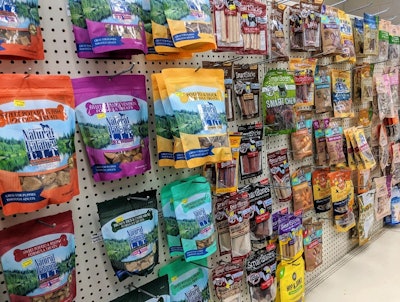
The U.S. pet product packaging market reached an estimated US$3.6 billion in 2017, with pet food and treats accounting for 86 percent of those sales. This data was revealed in a new Packaged Facts report, Pet Product Packaging Innovation, and it’s interesting that the percentage is more than double pet food’s share of the overall U.S. pet market, at 42 percent, according to figures from the American Pet Products Association.
Another interesting aspect to the packaging sales data: while dry product sales dominate the pet food market — globally, dry dog food sales reached US$32 billion last year, nearly 43 percent of the US$75 billion pet food market, says Euromonitor, and in the U.S., the category’s share was nearly 59 percent of pet food sales in the pet specialty channel, according to GfK — dry food packaging accounted for only 31 percent of pet product packaging sales. Wet pet food packaging and treat packaging were almost even, at 28 percent and 27 percent, respectively.
What explains the near parity among categories? Premiumization, says the Packaged Facts report. This long-standing trend impacts dry pet food packaging, too, but now is driving sales in the other categories more.
“The premiumization of pet food has been particularly important for the increasing shift to wet and refrigerated/frozen foods, which has prompted value gains since wet food packaging is intrinsically more expensive than dry food packaging,” the report says. This presents an opportunity for wet cat food especially, as nearly two-thirds of U.S. cat owners report buying that for their pets. “The continuing trend of humanization is also driving growth in pet packaging by expanding how many pet owners are giving their pets treats, which are packaged more expensively.”
There’s a great future in plastics
Of course, packaging material plays a key role in not only sales but also premiumization. For example, plastic laminates are the most common material used for pouches, an increasingly popular packaging type for treats as well as smaller bags of pet food. Such pouches offer a “sense of luxury to the consumer over bags but at a higher cost,” the report reads. And for dry pet food, though paper bags remain the most common material used, Packaged Facts says plastic is approaching paper in terms of value, projecting that it will surpass paper within five years “because of its increased use for premium and superpremium pet food brands.”
Likewise, plastic pouches are becoming more widespread and popular for wet, frozen and refrigerated pet food, though cans still dominate for wet products, with plastic trays slowly gaining ground. For pet treats, Packaged Facts projects plastic pouches will reach a 65 percent share this year.
One of the downsides to plastic packaging material is that it’s not very sustainable, an issue becoming more important to pet owners, especially millennials. Packaged Facts’ consumer surveys show that 30 percent of U.S. pet owners who buy pet food try to avoid products with excess packaging, yet only 18 percent consider the use of recycled, recyclable or biodegradable materials in pet food packaging important. Packaging attributes such as convenience and product freshness rank higher among pet owner preferences.
How packaging can help drive pet food sales and growth
For pet owners and pet food brands alike, what’s inside the package is the most important aspect of all; yet packaging can help spur sales and growth. The Packaged Facts report identifies these opportunities:
- Pet product sales and premiumization — for a mature market, U.S. pet product sales are still enjoying modest annual growth, and at the same time, premiumization remains strong, especially with pet food.
- Hispanic pet owners — among all U.S. dog and cat owners, Hispanics are more likely to agree that high-quality packaging reflects higher quality pet food inside (46 percent compared to 37 percent overall), according to Packaged Facts surveys.
- BPA-free pet food cans — while about 90 percent of cans used for human food now have linings free of bisphenol-A (BPA), a potentially dangerous chemical, says Packaged Facts (citing the Can Manufacturers Institute), the pet food market has been slower and less transparent about using such cans. “Thus, companies who verifiably show the BPA-free status of their cans should use this as an important marketing tool,” the report reads.
- Single-serve wet pet food packaging — with the rising popularity of small breed dogs, as well as more product innovation in cat food, 32 percent of cat and dog owners say single-serve package sizes are important for the wet pet food they’re buying. “The format is ripe for strong growth over the next few years,” says Packaged Facts.



















